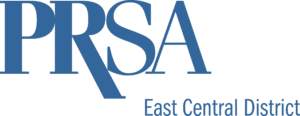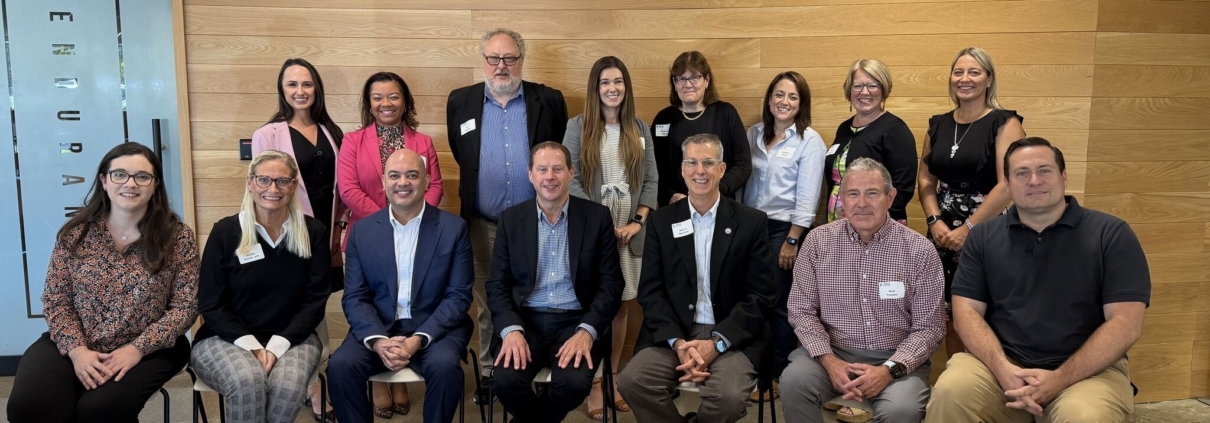ON THE MOVE & EMBRACING CHANGE? 2025 ECD CONFERENCE LEAVES NO DOUBT
By Mark Pompilio, ECD Chair-Elect (Author did NOT use AI writing assistance)
The 2025 PRSA “Leave No Doubt” East Central District Conference on Sept. 13 left no doubt about what it pledged to deliver. The goal was for attendees to leave Dublin, Ohio with new understandings of their work, their colleagues, and themselves. They would also be leaving behind the familiar Columbus area home of the district conference for the new ground of ECDC Detroit in 2026.
ECDC 2025 was unique in that it headlined keynote addresses by both new PRSA CEO Matt Marcial and National Chair Ray Day, APR. It grew to a record number of 50 registered attendees representing 11 of the district’s 15 chapters. It featured five outstanding speakers presenting on the most intriguing topics in PR today while utilizing the spacious International Center for Creativity for engaging Q&A and explorative breakout sessions.
Matt and Ray opened the conference with keynote remarks advocating for a PRSA that is on the move, meeting challenges and embracing every opportunity the future will bring. They were perfectly in step with the ECDC theme, “Leave No Doubt” about the messages we create, the path we take, and the promises we make.
ECD Chair-Elect and ECDC 2025 Chair Mark Pompilio said planning the conference meant hearing and responding to two key concerns from colleagues.
“A big topic was the atmosphere of uncertainty,” said Mark. “What are universally accepted beliefs? What are facts? How do we advise our clients and employers when they sense the world is off-balance and uncertain?
“The other dominant concern is AI. Will it take our jobs? Will it change what it means to create?” Mark illustrated with the Microsoft study that ranked PR 23rd on a list of 40 jobs most likely to affected by AI.
PRSA CEO MATT MARCIAL: WHERE WE STAND TODAY
Matt Marical has been on the road often since becoming PRSA CEO in March 2025, introducing himself to members. He got an early opportunity to meet several ECD members by attending the Friday, Sept. 12 ECDC Mixer at COhatch Dublin and graciously helping recognize ECD Diamond and Prominent Award winners. He kicked off the formal conference agenda on Saturday, Sept. 13 by delivering a “State of the Society” address that included his vision for an evolving PRSA.
“We’re in a transformation for our organization,” Matt told the attendees. Retention has slipped to 75% overall, with the “staggering” 50% loss of first-year members. He pointed to the impact of employers no longer funding dues; the perception gaps between a strong reputation yet weakness in innovation and cost-effectiveness; plus, competition from other professional development options, all of which he called “the biggest challenge and opportunity.”
He said building for our future includes the structural changes with new COO Amber Shaverdi Huston, stronger external partnerships and diversified revenues under new Business Development VP Alexandre Bouche, and chapter and section support under Senior Director Lynette Smith.
“Right now, we have the two revenue buckets of membership dues and annual conference,” he said. “The pandemic taught us we can’t continue that way – chapter and district – we need integrated partnerships.”
He said 90% of member engagement comes at the chapter and district level and said Smith will champion chapter and section support with an emphasis on culture and collaboration.
Brights spots for the organization include new members joining faster than in 2024. “It’s not an easy structure,” he said. “The difference between levels chapter to national and the student pipeline is critical to see value.”
“I heard we send a lot of emails to members!” he said, siting a common complaint. “It’s not just national. How do we scale it down?” Key improvements in content duplication, design, frequency, and segmentation had already increased CTR to 5.6%
He highlighted the DEI and ethics portal updates on the website and additional APR resources, an especially relevant tool to Matt who is pursuing his APR. He talked about new member acquisitions campaigns including auto renewal, a membership anniversary gift incentive, and the new Future Con next-gen events for communicators.
He talked about program expansion in 2026, including APR prep, women in PR, young pro recognition with training topics, and more education on the road focusing on how to partner more and bring relevant content. He pointed to some member communication gaps in available education, saying, “How many people don’t know we have professional interest sections?”
“Our profession is evolving rapidly,” he said. He called AI the “hot topic” and said AI, media monitoring, and digital transformation are lead priorities. PSIA must deliver innovation, value, and relevance with key outcomes to strengthen retention, drive revenue growth, and expand professional development reach.
Matt concluded by restating his growth strategy: Build back membership, support chapters and districts, grow and diversity revenues, and position us as global leader in communications.
“We’re facing challenges, yes,” he said. “But our momentum is real. Together we will move the needle.”
NATIONAL CHAIR RAY DAY, APR: STRATEGIC PLAN INSIGHTS, MEMBERSHIP TRENDS
The morning session’s focus on PRSA leadership continued with National Chair Ray Day, APR, an ECD colleague from Michigan unabashed about taking shots while on the home turf of a traditional rival.
“It’s good to be in Ohio,” Ray proclaimed, “and I don’t say that too often!”
Ray surprised the crowd by admittng that he was some 30 years into his career before being pulled into PRSA through the insistence of longtime colleague Brandi Boatner.
“The power of us, the power of human beings, the power of being invited,” he said. “I saw a passion in Brandi, the same passion I see in everyone here this Saturday morning.”
“Most organization serve a niche, we serve the broad section,” he said. “Nothing is more powerful than opening doors. I wish we could bottle up the passion, the passion here is unique. Flat membership, we’re not rolling in dough by long shot, but that passion is an opportunity and as leaders of this organization we need to remember that.”
Ray focused much of his talk on insights gained from Strategic Plan Research and Insights, gathered by Hanover Research earlier this year.
Perceptions of PRSA:
- Strong brand recognition and reputation.
- Weakest on innovation, future-forward, cost-effectiveness.
- Current members see PRSA as future-forward (77%), others do not.
- In-person events matter more to current members (65%).
Stakeholder Sentiment:
- Nonmembers: Tech-savvy, younger, spend more on PD but prefer networking/LinkedIn; low awareness of PRSA benefits; seek leadership and recognition.
- Lapsed Members: Disillusioned, price-sensitive, cite low value/ROI; perceive PRSA as out of touch; prefer discounted, bite-sized PD.
- Current Members: Happy overall; main concern is high PD cost; strong benefit awareness but gaps in research and mentorship.
Conclusions about “What Professionals Want” identified the “Top Topics” of digital transformation (71%) and media monitoring (70%). AI had a high appeal across all segments, but DEI initiatives ranked last in importance. Their preferred connections were email and newsletters, events, and social media.
Insights about the cost of membership showed PRSA is priced appropriately for current members and non-members, lapsed members are more price-sensitive, non-members spend most on professional development, and tiered pricing might capture different segments.
Addressing membership trends, Ray said new member joins and reinstatements are slightly up compared to last year, but a membership decline in June is likely due to some companies dropping group memberships because of budget cuts.
He said outreach strategies include refreshing membership materials, an updated membership application, evaluating opportunities for exclusive member benefits, and special offers for group prospects, such as free access to AI Tools videos.
Ray is proud of the “Membership Mondays” program he initiated because it is fostering direct engagement and providing valuable information sharing. (Second Monday open to all, Fourth Monday exclusively for leadership). To date it has more than 4,200 attendees and more than 6,990 registrations.
“We need to constantly be talking about the plan,” said Ray. “We decided our vision is to be the premier professional organization in this business and it touches everyone in every stage of their journey in this profession.”
Q&A WITH MATT & RAY
For Ray: What was your platform to be chair?
Ray: Getting closer personally to our members; giving them what they need at this stage in their lives; getting closer to drive membership. It’s about moving. Sometimes we’re set in ways, stuck in what we’ve done. We have to move much more quickly.
Matt shared his sense of urgency for moving forward. “We have to be operating at the speed of news and the speed of business.”
Matt asked members “How are we doing?” in their chapters.
- Megan Bonelli from Detroit said we are optimistic about our young pros.
- LeMar Holliday from Hoosiers said they are connecting with PR agencies about hosting events, so they can see the value.
- Pittsburg is working on turnout at other times of year other than main events and awards.
- Miami University PRSSA is concerned about the cost, asking organizations to pay dues for employees, personal expense with national, chapter, etc.
- PRSSA students said they want to convert to PRSA after graduating but don’t know; they want to push for discounts on membership dues.
- Membership at Miami is up. Northern University PRSSA membership is up also.
- Rick Chambers from West Michigan said when they get an alert from national about someone falling off, they reach out and ask “tell us why you left,” but no one answers the email. They have a strong relationship with PRSSA because once they are in our chapter we provide resources, support.
- Northwest Ohio has more collaborations with local professional organization – including the ad club of Toledo, joint activities, programming, inviting people, more collaborations, and partnering with Bowling Green and University of Toledo in providing scholarships.
- Katie Neal from Thoroughbred said they are having more coffee chats, lunches, bringing out people who have stayed away; they have struggled with the 80/20 rule of volunteerism – it creates leadership challenge with many serving on the board a long time. It’s a problem of Movement! How build that pipeline?
More Q&A:
BJ Fischer from NW Ohio likes Member Mondays; but asked for more. What bucks the trends of everyone trying normal solutions? We still have questions.
Ray: We are at a moment when we should reinvent our playbook.
Matt: Ray is the more rebellious board member! The organization is steeped in tradition that needs to be shaken. Our brand equity is incredible. We need to build on our heritage but not live in the past. That’s our opportunity moving forward. New thinking, new challenges to what’s been done.
PRSA has strong brand recognition, and the data doesn’t support changing the name. The “Aha!” of the research – We can’t be one size fits all. Can do more in-person events but also need to do more. Who is the competitor? LinkedIn is probably one of biggest; Axios on the national level. They want to take over PR Week. They want events to be Axios based; they have prestigious awards coming up that will affect Anvil. Are we watching the right people?
John Palmer PRSA Board/Central Ohio: Some say they didn’t realize they lapsed or had competing reasons.
Matt & Ray:
- What pros want: AI appeal, data analytics – predicted analytics label over media monitoring. Want emails and newsletters (not 60 a week!)
- Price insights: lapsed members more sensitive; nonmember spend most on PD.
- Tiered pricing may capture different segments.
- Membership trends: groups dropped due to budget cuts. How many ask personally about doing a group membership? Opportunity.
- Why turn away any communicator – example photographers and videographers.
- Offer more freebies.
- Downs on groups, up on PRSSA, down on sections, down on membership overall.
- More involving with early-to-mid professionals and losing the mid-to-late. Some are retiring. The magic is we are for everyone.
Ray: We have a killer leader now in Matt. He is putting together a world class staff. We need to become a growing organization.
Matt: Did we need a New York office (at cost of $1.5 million)?
Ray: In comes Matt – we’re not going to have it anymore! Take it off our back and put it into members.
Final Thoughts: Harness heritage, harness passion, and think differently. We see from data we are not one size fits all. The current base is generally happy, but we have to change to grow. Pricing, dues, events standpoint. Never forget the power of a personal invitation.
PETER EVANS: NEW RULES OF THOUGH LEADERSHIP – MATCHING ORGANIZATIONAL INTELLIGENCE TO USER INTENT IN AGE OF AI
ExpertFile Co-Founder and CEO Peter Evans began the professional development section of the conference with his presentation on New Rules of Thought Leadership. “I want to impart to you the importance of this golden age to communicators,” he said, “if – they get engaged.”
“AI will take your job?” asked Peter. “It’s not the job as we know it today. Organization will change structurally. Think broadly about comms today, about storytelling, advocacy, data analysis. A thought leader is generous and focuses on emerging ideas.”
Peter defined Thought Leadership as the practice of earning trust and influence over time by educating and inspiring – not selling. It involves named experts, original research, expertise, and evidence-backed points of view. It is expressed in engaging formats, credible partners, structured for AI to find and cite it, and provides practical next steps that move audiences to action, and delivers ROI.
He said the problem with advertising today is the “buy now” message to a large audience. He said, “95% are not actually looking in B2B. Warming up the 5% is what thought leadership does.”
Peter said there is an explosion of speaker’s bureau. “Organization are afraid to publish all of their people,” he said. “They don’t want them poached. But I don’t hear that anymore. It’s easy for people to leave. If you are not representing your people in a packaged way, you are losing out.”
3 Points of Pain for PR Pros:
- Reach – Earned media is harder to do with less journalists and newsrooms.
- Reputation – Public sentiment is eroding from a number of institutions – higher ed is considered an option. Disinformation in media and social makes it harder to break through.
- Resources- Budget cuts, less staff, skill gaps, coupled with the increased complexity in tech to manage.
The 4 A’s – Major Trends Impacting Comms:
- Attention – The death of the follow button (unhooking it to make money); thumb scroll behavior, short form media is a mistake. Brains are being shaped by it.
- Authenticity crisis – We haven’t seen what deep fakes are capable of.
- Access crisis – A power shift in distribution, packing everything in generative answer instead of going to blue links at the bottom. Expected those links will disappear, complete generative search will change the game. Google is not providing full data in generative searches.
- Automation – Originality and human connection have become the defensive mode for brands. We don’t need a PR department because we have Agentic AI at industrial scale.
Peter outlined research on how humans process information: Neuroscience – journalist just knows a good story. Storytelling – basics put forward. Perceived value – think broader. Influencing behavior is getting our audience to “A-C-T” by gaining Attention, evoking Curiosity, and earning Trust.
He talked about how the Reptilian Brain triggers emotion leading to the immediate repost. Negative triggers are: don’t bore the reptilian brain, don’t confuse it, don’t scare it. He said the Rational Brain is relevant, engaged, credible, influential, and responsive and applied it to how journalists discover expert sources.
10 Principles of Thought Leadership:
- Problems – Have a deep understanding of your audiences.
- Perspective – Don’t be afraid to stand out, to be contrary.
- Personality – Show humanity and lived experience, you can’t be selling in thought leadership.
- Principles – Don’t be transactional.
- Proof – Back up with data and do mix of data.
- Presence – Learn unique styles and channels to expand reach and engagement.
- Prominence – LinkedIn profile is important; Show your expertise to build authority and trust.
- Promptability – Optimize meta structure of your website with snack-able content your experts put together for AI searches.
- Partners- Co-creation improves research and expand through collaboration.
- Priorities – Show your audience your actions, move them to action, and show the path forward.
BREAKOUT GROUP: 3 BIG THINGS WE LEARNED FROM PETER: 1) Thought leadership is not transactional/avoid sales pitch; 2) Thought leadership involves laying a groundwork/framework for the person you’re looking to promote/amplify. (But don’t hold on to the past, keep it relevant to the person); 3) Keep it authentic, thought-provoking and relevant.
ANNA POMPILIO: EVOLVING AT THE SPEED OF CULTURE – TRENDS 101
“We are not fortune tellers,” Marks Strategy Director Anna Pompilio said to begin her “Evolving at the Speed of Culture – Trends 101” presentation. “We look for shifts and what they mean for industry.”
“We articulate the ‘so what?’ at the end of all the client information. Trends influence every industry and whatever we do. Cultural codes, shifting ideologies, patterns of change – our feelings one way to another way.”
She illustrated with the Rogers Diffusion of Innovation Curve with innovators (2.5%) and early adopters (13.5%) in the emerging stage, rising to early majority (34%) at the mainstreaming phase, reaching late majority (34%) and laggards (16%) by the mature phase.
“It’s the coolest person you know, up the curve, to mainstream to grandma asking you about it,” she illustrated. “Innovators, early adopters, early majority late majority laggards – global movement is not a trend.”
Four Altitudes of Trends:
- 2-3 years – Aesthetic: Inform emerging design and commercial innovation.
- 3-5 years – Category (micro): Behavioral in nature, informs innovation and retail/channel.
- 7-10 years – Socio-cultural (macro): Useful for long-term positioning, brand strategy that will influence future consumer behaviors.
- 15+ years – Demographic: Useful for anticipating changes in cultural make-up, how lived experiences frame perceptions, future proofing brand reputation.
Anna noted the “Five Altitudes of Trends” with “Viral Trends coming in a matter of weeks or months. They are heavily influenced by social media, linguistics, and pop culture and inform quick-churn marketing, comms and campaigns.
Foresight Process
- Cultural landscape scan – Assess trend-driving media and data.
- Analysis and pattern recognition – Examine the cultural landscape.
- Strategic synthesis – Distill shifts that present the greatest opportunities.
- Vetted territories – Curate shifts to connect a brand to opportunity in emerging culture.
“We put the Proctor & Gamble filter on and ask how they would do it,” she said for example. “Why do people care?”
For us this could look like this: Anticipate story angles journalists and news outlets will care about, guide clients toward relevant and resonant messaging, and create campaigns that feel native to cultural conversations.
Let’s look at an example: Anna asked, “WTF is a Borg?” The focus of this case study is not a cyborg. It’s a plastic gallon milk jug popular among college students for mixing water, vodka, flavoring, and electrolytes. “If all you have is a hammer, everything looks like a nail,” she said. To an ethnographer the key takeaway is college students are drinking more liquor than ever before. To a marketer, it might be an opportunity to sell more liquor in different packing with fruit flavors. To a cultural strategist, the question is “What’s in the juice?” Understanding drivers of a shift help us understand its impact.
Think Like a Cultural Strategist Checklist: What makes tomorrows trend-hunters different?
- They actually understand authenticity: Knowing the difference between cultural substance and social media noise – going out in the world and try new things.
- See the big behind the small: Have the almost supernatural ability to spot tiny shifts in behavior that signal bigger changes coming.
- Must be sort of weird: Or at least gets excited by the weird, wonderful ways people are rebuilding the meaning in their lives.
- Not benchwarmers: Don’t watch culture from the sidelines – they’re in it, living it, feeling its rhythms and can translate cultural intuition into brand opportunities.
Build your bibliography: stretching your brain; accuracy is efficacy; info is everywhere.
Notice what you notice: Let the sensing do the talking. Kill your darling! (Don’t allow personal subjectivity to affect the outcome. Write it down. Record the connections you make (even if they don’t feel like they mean anything, maybe they will).
Connect the dots: Like with like – one example does not a trend make – showing up in 2 or more places. Ideas can be placed together to create the beginning stages of themes; it’s OK to “parking lot” ideas that don’t fit. Synthesize/pare down. Ask what’s current today? When did the status shift? Where will things head? How will this change effect culture?
“An easier way to get into new trends,” said Anna, “Is to see what is trending and what is opposite. Counter trends always exist.”
Define the shift: But why? Consider the drivers, the factors that make this trend possible. STEEP (Social, Technological, Economic, Environmental, Political factors of influence) help us understand why a trend may be happening. Consider implications. What are the implications or outcomes this trend could have on society?
Think forward: Make it digestible with a wide breadth of research distilled into a scenario that makes the trend understood. Support your trend, with in and out manifestations, which are signposts that have connection to support the trend. So what? Once relevant trends have been identified, it’s important to translate them into actionable steps or relevant implications.
“Without inspiring implications,” she said, “we’re trend reporting, not forecasting.”
How to Identify Trends?
- Is what I’m seeing new?
- Is what I’m observing a shift in values, emotions or belief?
- Am I observing this manifesting in 3 or more places within the culture.
- What are the implications – the threats or opportunities this change presents – and are you poised to act upon them?
BREAKOUT GROUP TASK: Anna provided two worksheets: Question 1. Is What I’m Seeing New? Question 2. Is This a Shift in Values, Emotions, or Beliefs?
3 BIG THINGS WE LEARNED FROM ANNA: 1) STEEP was a great insight for me; 2) What is a trend compared to a movement; 3) Not every trend connects with your brand.
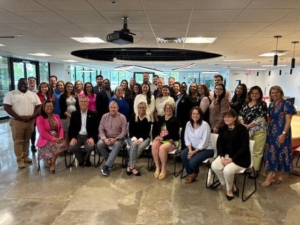
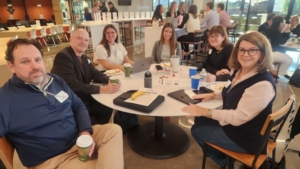
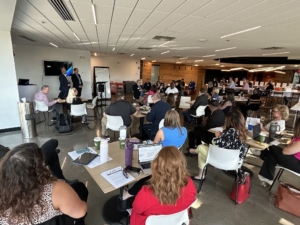
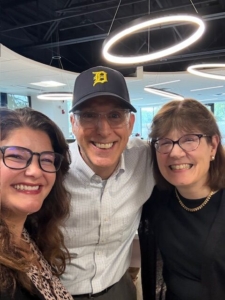
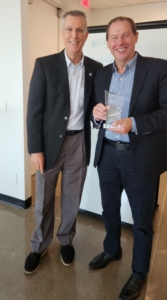
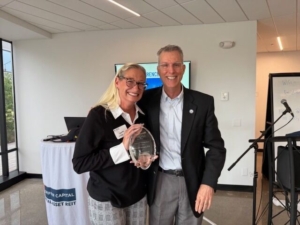
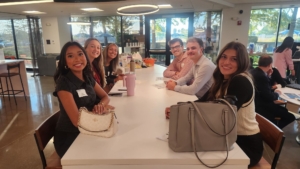
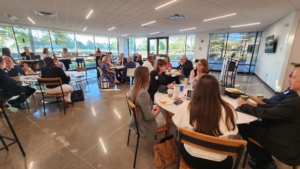
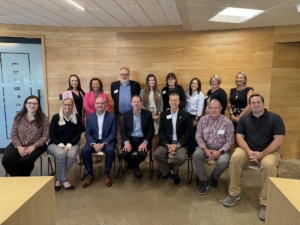
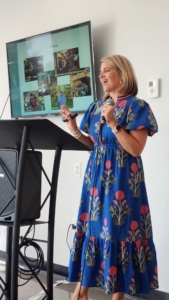
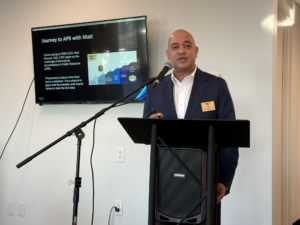
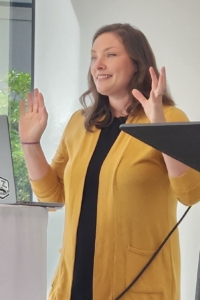
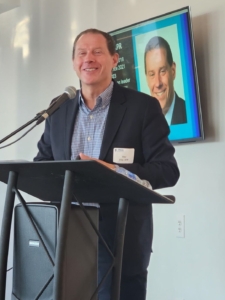
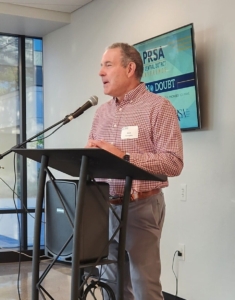
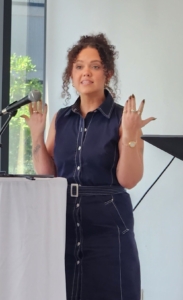
CORINNE JORGENSON: AI FOR COMMUNICATORS – WHERE WE ARE TODAY AND WHERE WE ARE HEADED
“Where are we?” asked Corinne Jorgenson, Parallax Advance Research Director of Proposals, to begin her talk on “AI for Communicators. “AI comes up in every discussion. It feels new, but it has been around a long time, it’s just in a new era.”
She tracked AI’s emergence in 1950 with the name coined in 1956. There was an AI winter until 1970 with expert systems that could play chess. Another AI winter was followed by the 1985 development of speech and handwriting recognition. An explosion came in 2000 with AI everywhere, including spell check. In 2010 AI made data more available. In 2016 AI beat humans at GO, and in 2022 came ChatGPT.
“AI is NOT intelligence,” said Corrine. “No brain, no thinking, not creative, not reasoning. AI is math. Sophisticated algorithms to derive answers.”
She illustrated with a “Do You Want to Build a Neural Network?” exercise. The task was to build AI that can identify the word “dad.” We first build nodes for each piece of information, with the three letters of “dad” in the input layer. The summation node is the hidden layer and the answer is in the output layer. The letter “d” is assigned the number 1 because computers think in numbers. Tokens are the symbolic value. We then add rules that interpret the weighted value and through multiple hidden layers it correctly identifies what is not the word “dad” in the output layer.
“AI is not intelligence,” she concludes. “AI is math. AI is a system of values, weights, and rules. It does not make moral judgments. AI is not a moral agent. It does not know right from wrong. The humans who build it bake in their own biases, blind spots, and choices. Humans must make ethical judgments. You cannot outsource your credibility to AI.”
What does that mean for communicators? Humans are responsible for AI ethics – developer and user like us.
“For communicators, this means you can’t outsource credibility or accountability,” she said. “If an AI-generated statement is misleading, the public won’t blame the tool, they’ll blame you or your organization.”
“Built-in safeguards have limits,” she said about guard rails at the output layer stage. “We can fact check, but don’t replace editorial judgment, the fact checking and ethical judgement we hold each other to. As it becomes more safety critical, it is more important to apply ethical judgement. It’s not going to solve itself; it won’t learn on its own to become more ethical.”
Weight errors in the summation node reveal the illusion of “self-resolving” ethical issues. “700+ million use ChatGPT every week, and to have weighting error, that is misinformation at scale,” she said.
MID-SEGMENT AUDIENCE EXERCISE:
Corinne asked the audience to turn to the person next to you and discuss “Should audiences be told if AI used in building content? Why or why not?”
Comments:
- It’s not a binary decision; it’s not that simple. It becomes credibility issue. If I spell check I’m using AI.
- Jen Kramer: Not all the time, simple info search for example.
- BJ Fischer: Did you use it for brainstorming or an outline? You have to be responsible.
- Corinne: The academic world goes journal by journal. Some say if you use it, credit it as co-author or cited source – some level not done by you. Keep a balance. The nuance here is because we are using it all the time. Research says if you expose its context (AI draft edited by human team) it builds trust with readers. You are still applying human talent to the problem.
Corinne said it matters how we create guidelines for using AI in our organization. We often are explaining our company policy. The importance of a well-planned ethical AI polices: You are not just AI users, you are policy shapers, helping set the tone for responsible adoption.
“AI itself is not unethical,” she said. “It’s not a moral agent. But how we use it could be. Policies we use will determine how people will trust us.”
“Will AI take my job?” was the question for her focus on human-machine teaming.
The role of the communicator in 2021 included judgement, narrative building, creativity, trust, summarizing, pattern recognition, grammar and spelling. In 2025 the distinctly human tasks are judgement, narrative building, creativity, and trust. The role of AI in 2025 is summarizing, pattern recognition, grammar and spelling. The new capacity is the combination of roles in the Human-AI team.
Corinne concluded with tips and tools:
- Hemingway – Helps complete writing.
- Jenni – For people who like to do their own fact-checking; academics.
- editGPT – Hyper-specialized tool editors use, similar to Hemingway.
Katie Neal asked if you use all three, what should be the order?
Corinne said, Jenni for first draft, editGPT to make sure it complies with style, Hemingway to make it plain language that is easier to understand.
TOP TAKEAWAYS
- AI is not new
- AI is not intelligent
- AI is just math
- AI is not a moral agent
- Humans are responsible for AI ethics
- AI itself isn’t ethical
- Responsible AI use promotes trust
- AI elevates your capacity.
BREAKOUT GROUP 3 BIG THINGS WE LEARNED FROM CORINNE: 1) AI is not intelligent, it’s math; 2) AI can have bias; 3) AI and humans should be a team.
LAUREN PARKER: BREAKING THROUGH THE NOISE – RETHINKING MEDIA STRATEGY IN A FRAGMENTED, AI-DRIVEN WORLD
Slide Nine CEO and Co-Owner Lauren Parker continued the exploration of AI at ECDC 2025 with escalating impact on PR. She began by time traveling to the 1980 with just a few network broadcast channels. “Today more than 150 zettabytes of data are added to internet each year,” she said, “and how it has changed attention. We’ve seen how much more difficult it is to capture attention of reporters.”
She traced the timeline: 1990s Access, the internet goes mainstream; 2000s Sharing, social media emerges; 2007 Immediacy of the smartphone revolution; 2010s Curation of algorithm-driven feeds; and 2020s Synthesis with the rise of the AI and LLMs.
She described traditional media in decline with more than 21,000 media jobs cut last year. Newsrooms are asked to do more with less and trust of media is at an all-time low.
“So much content is available, people don’t want to get behind the pay wall,” she said. We now see more independent journalists in non-traditional avenues. People are looking for credible sources and it’s cheaper for editors to look for sources on Substack.
“AI is changing everything,” she said. “There is a lot of good, scale and speed, soft partnering, relevant media angles, personalization at scale. LLM digest large data. We’re trying to use these tools for the better.”
The challenges include accuracy and trust issues, finding inaccuracies and distortions a human editor could pick out. Reality is the new gatekeeper, determining how consume content.
“The goal in search results used to be to get the number one spot,” she said. “Now because of Goggle AI overviews, it’s now position zero, totally new context. There’s no click search – quick answer and not going deeper. That used to be the SEO goal.”
“How do we get AI to recommend our brand? Is now an important question, said Lauren. “We’re looking at AI as a black box; how does it work? Kind of like the Matrix. How does it operate, how does in scrape information?”
She said 95% of AI citations come from unpaid media, 85% earned media. “Earned media has become new SEO as well as other informed content. Fresh insights are rewarded. Owned and earned content more important than ever. We need to think about our media strategies in new ways.”
Peter Evans commented that the earned media citation might not be accurate because of the limited sample available. “Google has the full data but is not sharing it.”
Lauren said the shift is from getting clicks to being cited. She advised, “Have consistent ownership over your story telling and think broadly about journalists in the creative lane, focusing on active, relevant and timely stories.”
Optimizing Performance: Owned Media
- Schema markup & structured data – Ensure AI tools recognize and surface your content in summaries and searches.
- Optimal formatting and structure – Clearly written content, scannable headers and bullet points are more likely pulled by AI and easier for audiences to digest.
- Conversational content design – Structuring content around natural, question-bases queries is more engaging and more AI discoverable.
- Authoritative and trustworthy content (E-E-A-T) – Experience, expertise, authoritativeness, and trustworthiness. Features named experts, real data and case studies to build trust with both readers and LLMs.
Optimizing Performance: Earned Media
- Target media AI trust – LLMs pull from high-authority, third-party sources.
- Maintain a clear digital footprint – Audit search results, Wikipedia, LinkedIn & owned channels for accuracy; issue corrections if possible; refresh bios and ensure consistency across platforms so AI sees trustworthy brand.
- Craft snippet-friendly messaging – Coach spokespeople to deliver fact-rich soundbites; structure press releases, op-eds and interviews with clear definitions, numbered lists, and bold statements are easily lifted.
- Blend earned with owned amplification – Amplify coverage through owned channels (LinkedIn posts, podcasts, blogs, newsletters) to increase visibility, reinforce messages and boost chances AI scrapes and cites coverages.
Optimizing Performance: Creators/Influencers
- Partner with credible, niche creators – Map out micro and mid-tier creators in your industry who are consistently cited and prioritize partnership where creator is an authority, not just an entertainer.
- Focus on transparency and authenticity – Choose creators aligned with your values and allow them to tell your story in their voice. Provide facts, not scripts and encourage proper disclosure for credibility.
- Co-create content built for discovery – Encourage creators to use formats with e.g. lists, “how to solve Y,” “future of Z” that are more quotable, shareable, and AI-friendly.
- Amplify creator content cross-channel – Build system to amplify creator work, embed it on website, link to thought leadership, reference to press to multiple digital footprints.
Lauren concluded by saying that in the age of AI, success means intention and balance: A combination of owned media for controlled consistent storytelling, earned media as credible currency, and creators with authenticity and niche reach.
KATIE NEAL: LEAD WITHOUT LIMITS – TACKLING PERFECTIONISM, IMPOSTER SYNDROME AND BURNOUT
After a day of examining challenges and problem solving in the mission and purpose of PRSA, the new direction of thought leadership, the evolution of our culture, and the ground-shaking advances in AI, the focus of ECDC 2025 turned inward to the inner strength and capacity of each of our members.
Katie Neal of Katie Neal Coaching & Consulting and PRSA Thoroughbred President presented “Lead Without Limits” for the day’s final segment. She spoke from the lived experience of her own personal and professional challenges and the confident encouragement that comes from someone who knows the path from survival to success.
Katie set the goals of identifying patterns and pitfalls and learning and applying strategies to move forward with intention and confidence.
She began with the hidden trap of perfectionism. “We let perfect get in the way of ‘good enough,’” she said. Perfectionism is a double-edged sword because high standards, strong work ethic, mistake-free meticulousness, and mastery through persistence can lead to success and rewards.
She compared the characteristics of healthy striving vs. perfectionism: realistic goals vs. the unattainable, enjoying growth vs. self-criticism, and overcoming mistakes vs. fear of failure.
Perfectionist traits – all-or-nothing, workaholism, results-only, defensiveness, procrastination and rumination – ultimately limit success. They erode confidence, make small mistake seem big, increase stress, anxiety, and depression, lower self-esteem, sabotage growth and lead to burnout.
She described imposter phenomenon as the silent confidence killer.
Highly accomplished individuals paradoxically believe they aren’t good enough. Five types:
- The perfectionist – any small mistake means you are inadequate.
- The expert – feels like an imposter if they don’t know everything there is to know. Fear of being exposed as inexperienced (often in academia).
- The soloist – feels they must accomplish everything on their own.
- The superhuman – must excel in every detail in life (work, relationships, parenting, etc.).
- The natural genius – expects success to come easily and feels like a fraud if they struggle to master something right away.
How imposter syndrome holds us back:
- Avoiding opportunities (including leadership).
- Overworking (often to the point of burnout).
- Discounting achievements (or calling them luck).
- Playing it safe (stalling leaning and growth).
Katie called burnout “the smoldering crisis.” She said 50% of comms pros have considered quitting due to burnout; 64% have experienced extreme stress or burnout; 96% struggle to disconnect from work.
She listed the 12 stages of burnout beginning with a strong need to prove yourself. You work harder in stage 2 and are neglecting your needs by stage 3. “The first three stages are so commonplace for us we don’t even detect burnout,” said Katie. By stage 4 you are conflicted and blaming others; Stage 5 you focus more on work; Stage 6 you deny problems are due to work stress; Stage 7 you withdraw from social and family life. At stage 8 your behavior upsets loved ones and by stage 9 you depersonalize and don’t feel like yourself. By stage 10 you are empty and numb. At stage 11 you are depressed and exhausted, and stage 12 brings mental and physical collapse.
What’s at stake? Your performance and creativity, your career, your relationships, your sense of fulfillment, missed opportunities, and your health.
Are you at a breaking point or a turning point?
- Clarify your values (fundamental beliefs that help you determine what is most important to you). Values aren’t what we do or don’t do, they are what’s right or wrong (examples may include fun, adventure, etc.). Make sure what you do is aligned with your values.
- Be honest with yourself. (Ask – what’s the worst that can happen? What’s the most likely scenario? What is “good enough?” What’s the cost of not addressing your burnout?)
- Silence your inner critic. Create an environment where you feel accepted. Show self-compassion. Talk to yourself the way you talk to your friend.
- Celebrate your accomplishments. Don’t be so quick to move onto the next goal. Recognizing success activates the brain’s reward system. Scale awards accordingly.
- Set boundaries and say no. Being the last one online or first on call is not a flex – it’s a problem. Use these techniques to protect your time/sanity:
- Recognize what can be done now/what can wait
- Train others to do what they can so you can delegate
- Prioritize
- Time block
- Protect and use your PTO
- Turn off notifications after hours
- Communicate after-hours protocols with colleagues
- Strategically invest in talent – Working 24/7 can’t be the expectation. Consider one on one professional development opportunities such as peer mentoring and coaching. Rest is a performance strategy, not a luxury.
- Recognize when change is needed. Values are misaligned, chronic burnout, career stagnation, lack of recognition, toxic/abusive work environment
BREAKOUT GROUP TASKS: Katie provided separate worksheets for three groups: (1) Tackling Perfectionism; (2) Unmasking Imposter Syndrome; (3) Battling Burnout.
MARK POMPILIO: ECDC 5 BIG THINGS:
1)Thought leadership: Create framework for the person you amplify, don’t hold to past, keep it relevant.
2) Trends: See the opportunities that change presents and be poised to act on them.
3) AI and humans should be a team. Use it ethically.
4) Partner with EEAT: Expertise, experience, authoritativeness, & trustworthiness.
5) Talk to yourself like you to talk to your best friend; rest is not a luxury it’s a performance strategy.
MARK WEINSTEIN: FINAL THOUGHTS:
Mark Weinstein announced that ECDC will leave its traditional home in the Columbus, Ohio area and move to Detroit in 2026 with a tentative date of Sept. 11-12. Mark donned a Detroit Tiger/University of Michigan cap to celebrate the announcement!
